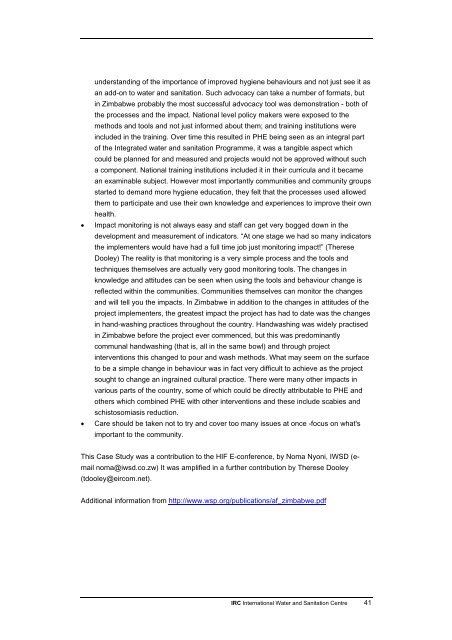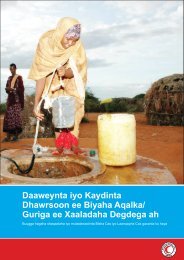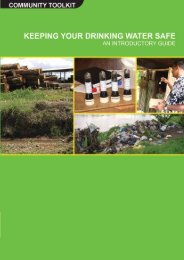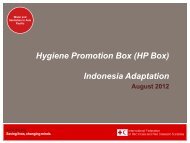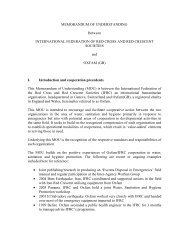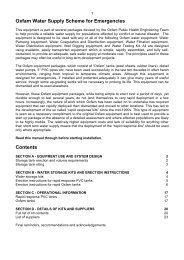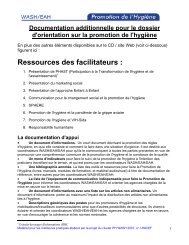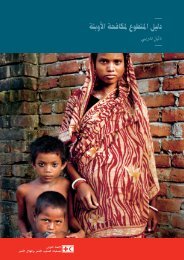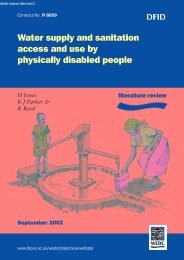Hygiene Promotion - IRC International Water and Sanitation Centre
Hygiene Promotion - IRC International Water and Sanitation Centre
Hygiene Promotion - IRC International Water and Sanitation Centre
Create successful ePaper yourself
Turn your PDF publications into a flip-book with our unique Google optimized e-Paper software.
underst<strong>and</strong>ing of the importance of improved hygiene behaviours <strong>and</strong> not just see it asan add-on to water <strong>and</strong> sanitation. Such advocacy can take a number of formats, butin Zimbabwe probably the most successful advocacy tool was demonstration - both ofthe processes <strong>and</strong> the impact. National level policy makers were exposed to themethods <strong>and</strong> tools <strong>and</strong> not just informed about them; <strong>and</strong> training institutions wereincluded in the training. Over time this resulted in PHE being seen as an integral partof the Integrated water <strong>and</strong> sanitation Programme, it was a tangible aspect whichcould be planned for <strong>and</strong> measured <strong>and</strong> projects would not be approved without sucha component. National training institutions included it in their curricula <strong>and</strong> it becamean examinable subject. However most importantly communities <strong>and</strong> community groupsstarted to dem<strong>and</strong> more hygiene education, they felt that the processes used allowedthem to participate <strong>and</strong> use their own knowledge <strong>and</strong> experiences to improve their ownhealth.• Impact monitoring is not always easy <strong>and</strong> staff can get very bogged down in thedevelopment <strong>and</strong> measurement of indicators. “At one stage we had so many indicatorsthe implementers would have had a full time job just monitoring impact!” (ThereseDooley) The reality is that monitoring is a very simple process <strong>and</strong> the tools <strong>and</strong>techniques themselves are actually very good monitoring tools. The changes inknowledge <strong>and</strong> attitudes can be seen when using the tools <strong>and</strong> behaviour change isreflected within the communities. Communities themselves can monitor the changes<strong>and</strong> will tell you the impacts. In Zimbabwe in addition to the changes in attitudes of theproject implementers, the greatest impact the project has had to date was the changesin h<strong>and</strong>-washing practices throughout the country. H<strong>and</strong>washing was widely practisedin Zimbabwe before the project ever commenced, but this was predominantlycommunal h<strong>and</strong>washing (that is, all in the same bowl) <strong>and</strong> through projectinterventions this changed to pour <strong>and</strong> wash methods. What may seem on the surfaceto be a simple change in behaviour was in fact very difficult to achieve as the projectsought to change an ingrained cultural practice. There were many other impacts invarious parts of the country, some of which could be directly attributable to PHE <strong>and</strong>others which combined PHE with other interventions <strong>and</strong> these include scabies <strong>and</strong>schistosomiasis reduction.• Care should be taken not to try <strong>and</strong> cover too many issues at once -focus on what'simportant to the community.This Case Study was a contribution to the HIF E-conference, by Noma Nyoni, IWSD (emailnoma@iwsd.co.zw) It was amplified in a further contribution by Therese Dooley(tdooley@eircom.net).Additional information from http://www.wsp.org/publications/af_zimbabwe.pdf<strong>IRC</strong> <strong>International</strong> <strong>Water</strong> <strong>and</strong> <strong>Sanitation</strong> <strong>Centre</strong> 41


